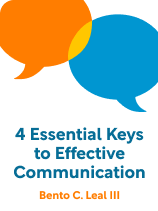

This article is an excerpt from the Shortform book guide to "4 Essential Keys to Effective Communication" by Bento C. Leal III. Shortform has the world's best summaries and analyses of books you should be reading.
Like this article? Sign up for a free trial here.
Are you preparing to have a hard conversation? Do you struggle with nonverbal cues?
In 4 Effective Keys to Effective Communication, Bento C. Leal reveals the communication errors that are damaging to relationships. When you fail to understand other people’s body language and other cues, it becomes harder to continue the conversation.
Continue reading to learn how to have difficult conversations.
1. Focus on Their Words and Body Language
To learn how to have difficult conversations, you must pay close attention to the other person’s choice of words, tone of voice, and body language so you can gain the most complete understanding of their perspective. Leal explains that these signals reveal their true thoughts and feelings.
For example, if someone says that they’re “infatuated” with their new partner, it doesn’t just mean that they “like” them—it means that they’re experiencing a short-term obsession and have probably been thinking about them nonstop. Similarly, if someone says that they’re “infatuated” with their new partner in a nervous tone of voice while knitting their eyebrows, this indicates that they’re probably concerned about their infatuation.
Communicating When You or Another Person Struggles With Nonverbal Cues
Leal explains that it’s crucial to focus on someone’s subtle verbal and nonverbal cues, like tone of voice and body language, to gain a complete understanding of what they’re trying to express. However, this advice can be limiting if you or the other person struggles to read and use subtle verbal cues or nonverbal cues, a common occurrence for people with certain disorders like autism.
People who struggle with interpreting nonverbal expression might fail to understand the meaning of cues like sarcasm or distress and consequently miss the deeper meaning of what someone is trying to express. They might also struggle to read body language. Alternatively, an autistic individual might not understand the appropriate uses of body language or tone. This often manifests as expressing themselves in a monotone voice or a tone that doesn’t accurately express how they feel—for example, they might use an elated tone to describe something they’re struggling with. This might cause others to misunderstand them.
- If someone struggles with nonverbal communication, try to use communication methods like text or email that don’t require them to watch for and interpret nonverbal cues.
- If you struggle to understand nonverbal cues, tell the other person directly that for you to understand them, they must express everything they’re feeling directly. If you’re the neurotypical person in this situation, try to be as clear as possible about your feelings and emotions in return.
- Ask what’s going on if you don’t understand—this goes for both parties. For instance, if you don’t understand the other person’s body language, ask them, “Are you angry?” “Are you sad?” and so on.
- If your facial expressions don’t always align with your feelings, inform the other person. For example, if you tend to have an angry resting face, inform the other person so they don’t assume that you’re upset when you’re not.
2. Continue the Conversation
The second practice of expressing yourself in a difficult conversation is allowing the other person to respond and then continuing the discussion until everyone is satisfied. Leal notes that this practice ensures that the conversation comes to a satisfactory end—both parties have fully expressed themselves and fully understand each other. If the discussion is about a problem that needs to be solved, continuing the conversation will ensure that a solution is identified.
To continue the conversation until its natural end, switch back and forth between listening and expressing yourself and follow the practices necessary to perform these abilities. At the end of the conversation, thank the other person for listening.
How to Continue the Conversation in Difficult Situations
The authors of Crucial Conversations agree that allowing the other person to respond, and switching back and forth between listening and expression, is the key to having an effective conversation. However, they note that this process doesn’t always go as planned. For example, you might accidentally say something that offends the other person, causing them to clam up in silence or react with violent communication. In these situations, they recommend taking a few additional steps that Leal doesn’t address.
First, the authors discuss how to continue the conversation in situations where the other person is hesitant to respond. This situation might arise if the other person is afraid to share their opinions for fear that you might judge them, get offended, or get angry. To encourage the other person to speak up, the authors recommend explicitly inviting opposing views, being sincere, playing devil’s advocate, and persisting.
For example, you can explicitly say something like “This is how I see it, but do you think I’m missing anything?” or “Do you disagree?” If they still don’t open up, you could take the devil’s advocate approach by guessing their point of disagreement: “Maybe I’m wrong, but what if…” If the other person still resorts to silence, continue to press for their opposing view.
The authors also make a few recommendations on how to respond to violent communication like yelling or accusing. If this happens, first, break the violent communication cycle by making the conversation safe again. This requires you to establish a mutual purpose (a common goal for having the discussion) and mutual respect (showing the other person that you genuinely care about their perspective). During this process, you might have to apologize or state your understanding of their perspective. Next, invite them to share the facts and story that explain why they’ve become so upset. In doing this, reassure the other person that you won’t react negatively to their honesty.

———End of Preview———
Like what you just read? Read the rest of the world's best book summary and analysis of Bento C. Leal III's "4 Essential Keys to Effective Communication" at Shortform.
Here's what you'll find in our full 4 Essential Keys to Effective Communication summary:
- How to avoid the two most damaging communication faux pas
- How to listen and express yourself with empathy
- Why having empathy for others starts with seeing the worth in yourself






